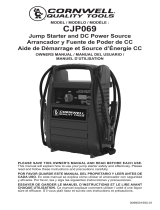
• 8 •
Using the USB Port8.4
The USB port provides up to 500mA at 5V DC.
NOTE: When using the USB port, the clips on the jump starter are live and will
produce arcing or sparking if they come in contact with each other. To prevent
accidental arcing, always keep the clips on the storage holders when not using
it to jump start a vehicle.
Ensure that the battery clips are securely clipped on the storage holders.1.
Plug the device into the USB port on the front panel.2.
Turn the Jump Start On/Off switch to the ON position.3.
Turn the USB device on.4.
Reverse these steps when nished using the USB port.5.
Charge the jump starter as soon as possible after using the USB port.6.
Using the Built-In Light8.5
Position the jump starter on a at, stable surface near the intended 1.
work area.
Ensure that the battery clips are securely clipped on the storage holders.2.
Press the Light Switch to the ON position.3.
The jump starter light will turn on and illuminate your work area.4.
Press the Light Switch to the OFF position.5.
Charge the jump starter as soon as possible after using the built-in light.6.
MAINTENANCE INSTRUCTIONS9.
After use and before performing maintenance, unplug and disconnect the jump 9.1
starter (see sections 3 and 4).
Use a dry cloth to wipe all battery corrosion and other dirt or oil from the 9.2
battery clips, cords, and the jump starter case.
Ensure that all of the jump starter components are in place and in good 9.3
working condition, for example, the plastic boots on the battery clips.
Servicing does not require opening the unit, as there are no user- 9.4
serviceable parts.
All other servicing should be performed by qualied service personal.9.5
MOVING AND STORAGE INSTRUCTIONS10.
Store the jump starter in an upright position. 10.1
Store inside, in a cool, dry place.10.2
Do not store the clips on the handle, clipped together, on or around metal, or 10.3
clipped to cables. The clips on the jump starter are live and will produce arcing
or sparking if they come in contact with each other. To prevent accidental
arcing, always keep the clips on the storage holders when not using it to jump
start a vehicle.
If the jump starter is moved around the shop or transported to another location, 10.4
take care to avoid/prevent damage to the cords, clips and jump starter. Failure
to do so could result in personal injury or property damage.
Do not use and/or store the jump starter in or on any area or
surface where damage could occur if the internal battery should unexpectedly
leak acid.














